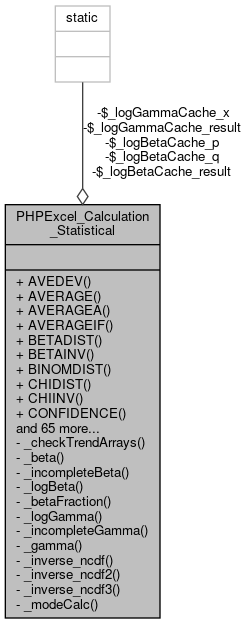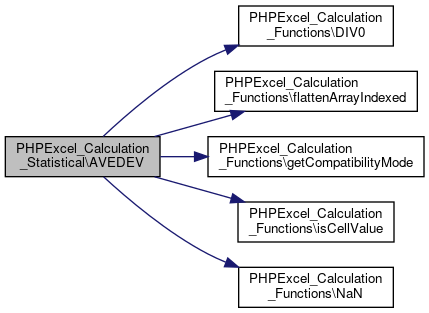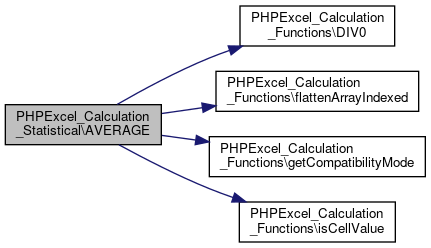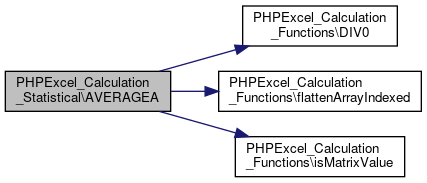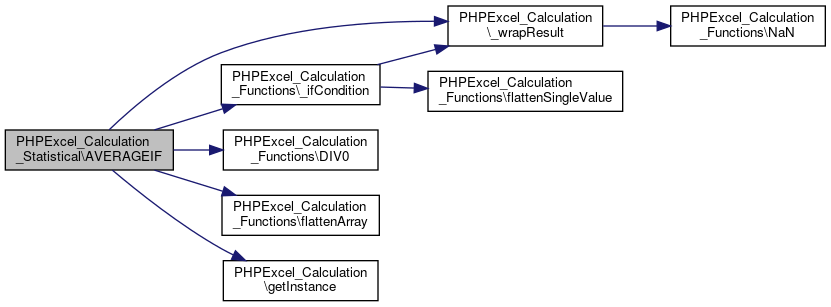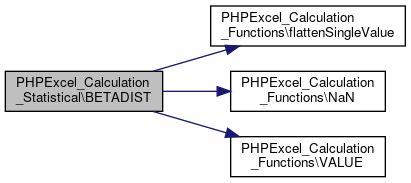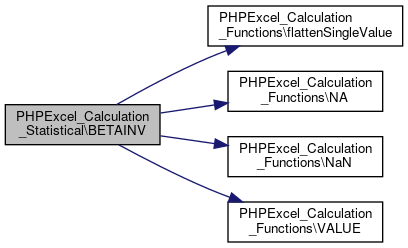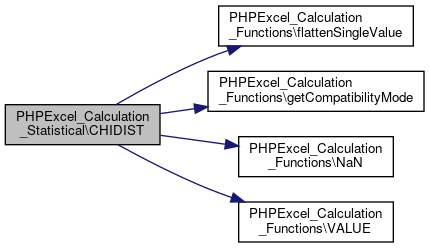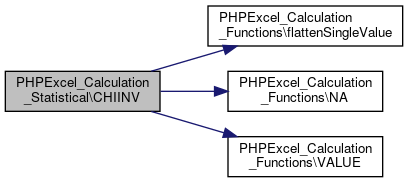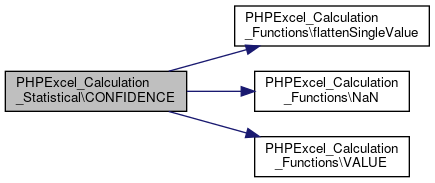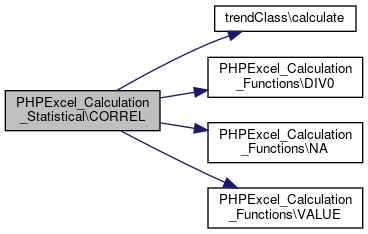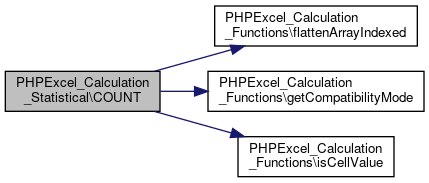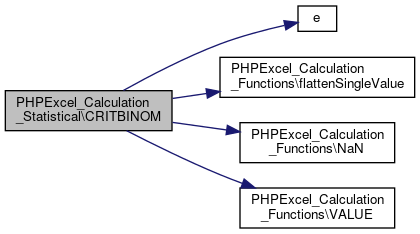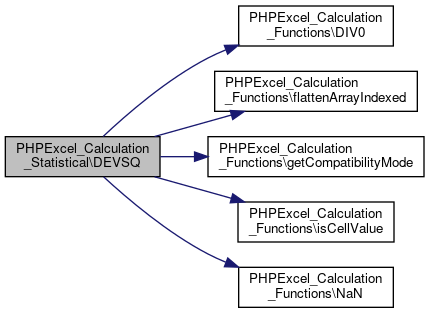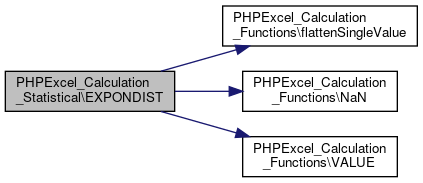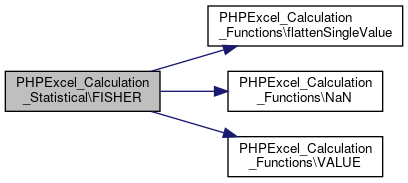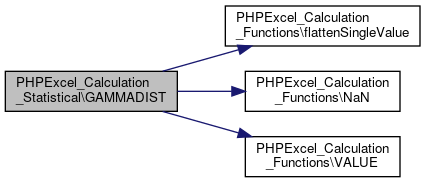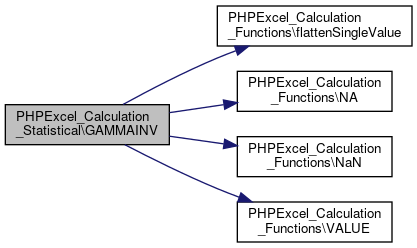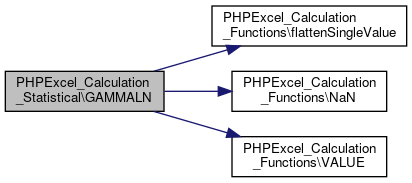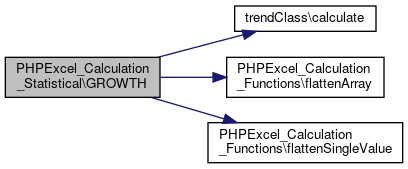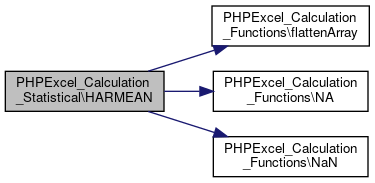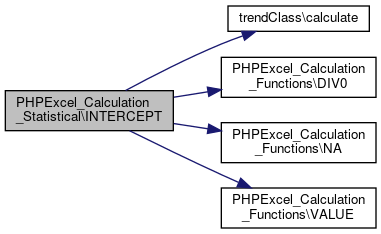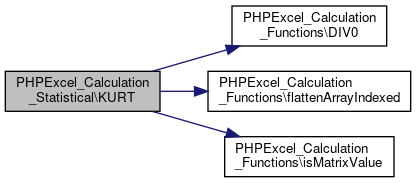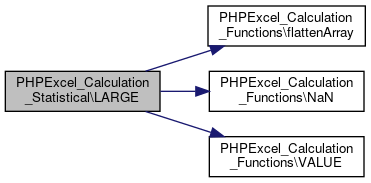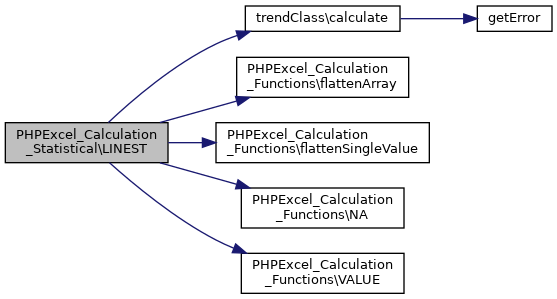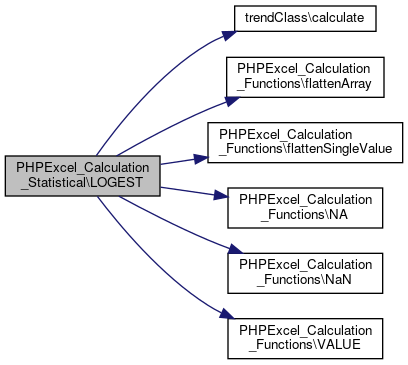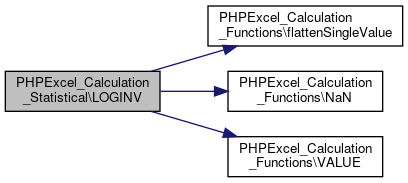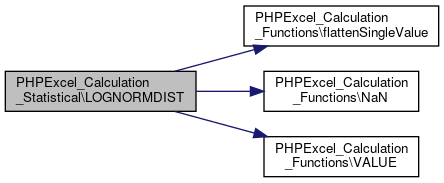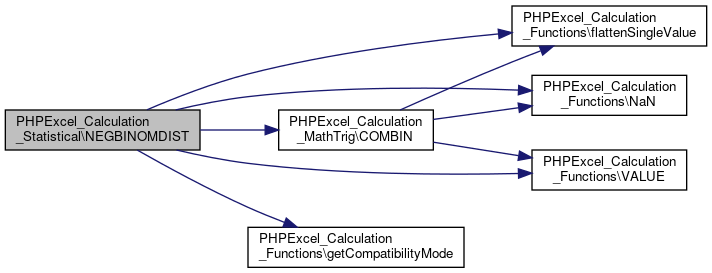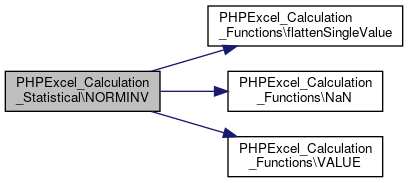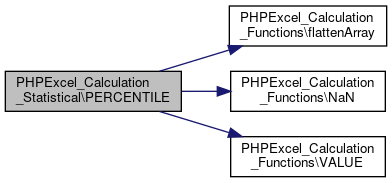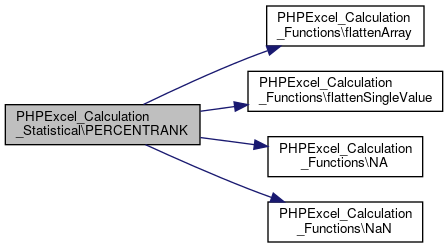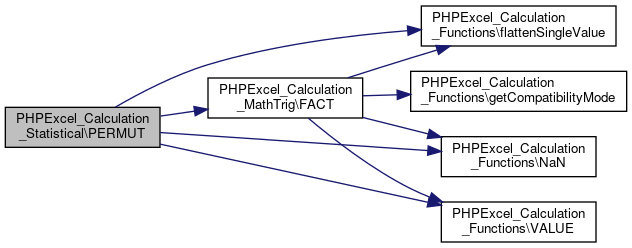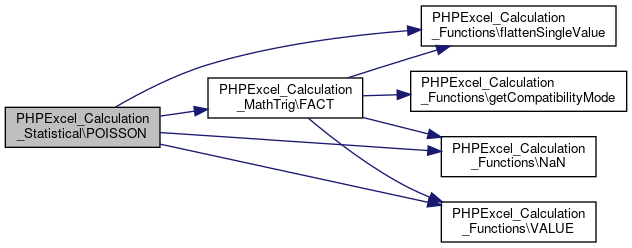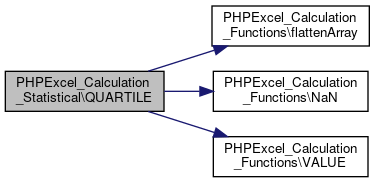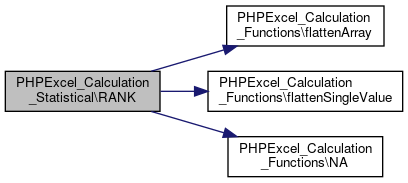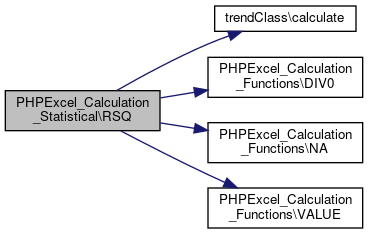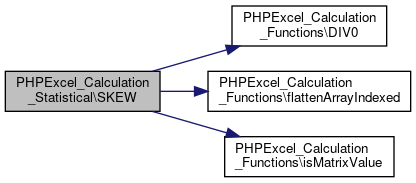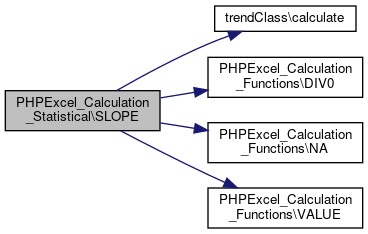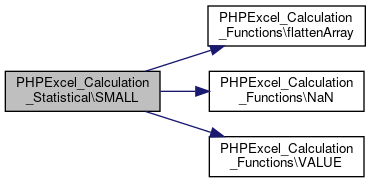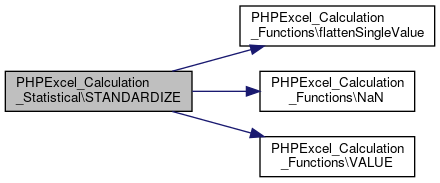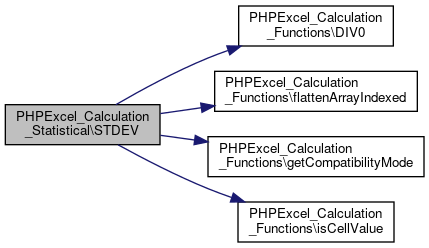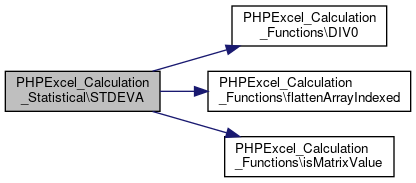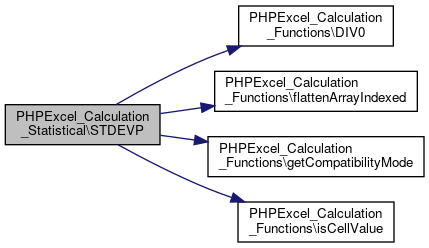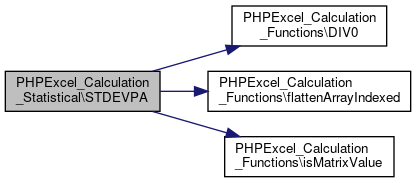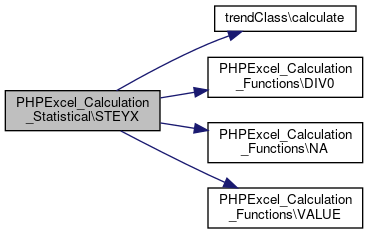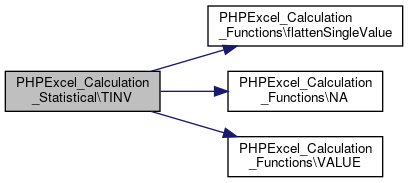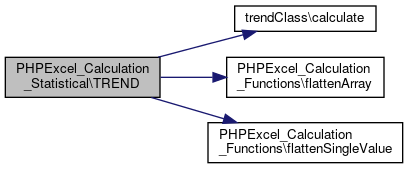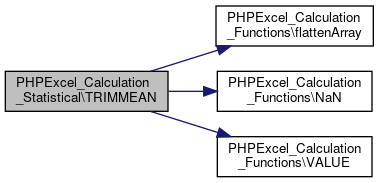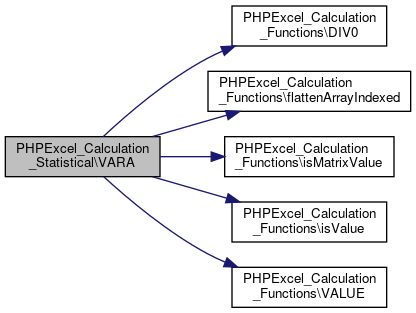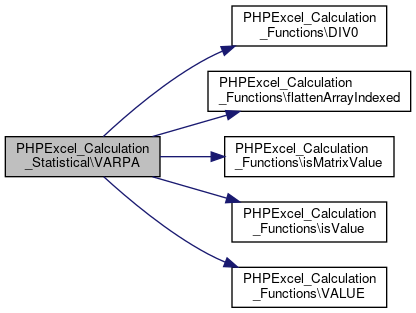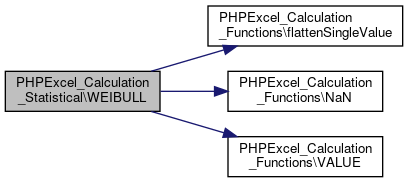 Collaboration diagram for PHPExcel_Calculation_Statistical:
Collaboration diagram for PHPExcel_Calculation_Statistical:Static Public Member Functions | |
| static | AVEDEV () |
| static | AVERAGE () |
| static | AVERAGEA () |
| static | AVERAGEIF ($aArgs, $condition, $averageArgs=array()) |
| static | BETADIST ($value, $alpha, $beta, $rMin=0, $rMax=1) |
| BETADIST. More... | |
| static | BETAINV ($probability, $alpha, $beta, $rMin=0, $rMax=1) |
| BETAINV. More... | |
| static | BINOMDIST ($value, $trials, $probability, $cumulative) |
| BINOMDIST. More... | |
| static | CHIDIST ($value, $degrees) |
| CHIDIST. More... | |
| static | CHIINV ($probability, $degrees) |
| CHIINV. More... | |
| static | CONFIDENCE ($alpha, $stdDev, $size) |
| CONFIDENCE. More... | |
| static | CORREL ($yValues, $xValues=null) |
| CORREL. More... | |
| static | COUNT () |
| static | COUNTA () |
| static | COUNTBLANK () |
| static | COUNTIF ($aArgs, $condition) |
| static | COVAR ($yValues, $xValues) |
| COVAR. More... | |
| static | CRITBINOM ($trials, $probability, $alpha) |
| CRITBINOM. More... | |
| static | DEVSQ () |
| static | EXPONDIST ($value, $lambda, $cumulative) |
| EXPONDIST. More... | |
| static | FISHER ($value) |
| FISHER. More... | |
| static | FISHERINV ($value) |
| FISHERINV. More... | |
| static | FORECAST ($xValue, $yValues, $xValues) |
| FORECAST. More... | |
| static | GAMMADIST ($value, $a, $b, $cumulative) |
| GAMMADIST. More... | |
| static | GAMMAINV ($probability, $alpha, $beta) |
| GAMMAINV. More... | |
| static | GAMMALN ($value) |
| GAMMALN. More... | |
| static | GEOMEAN () |
| static | GROWTH ($yValues, $xValues=array(), $newValues=array(), $const=True) |
| GROWTH. More... | |
| static | HARMEAN () |
| static | HYPGEOMDIST ($sampleSuccesses, $sampleNumber, $populationSuccesses, $populationNumber) |
| HYPGEOMDIST. More... | |
| static | INTERCEPT ($yValues, $xValues) |
| INTERCEPT. More... | |
| static | KURT () |
| KURT. More... | |
| static | LARGE () |
| static | LINEST ($yValues, $xValues=NULL, $const=TRUE, $stats=FALSE) |
| LINEST. More... | |
| static | LOGEST ($yValues, $xValues=null, $const=True, $stats=False) |
| LOGEST. More... | |
| static | LOGINV ($probability, $mean, $stdDev) |
| LOGINV. More... | |
| static | LOGNORMDIST ($value, $mean, $stdDev) |
| LOGNORMDIST. More... | |
| static | MAX () |
| static | MAXA () |
| static | MAXIF ($aArgs, $condition, $sumArgs=array()) |
| static | MEDIAN () |
| static | MIN () |
| static | MINA () |
| static | MINIF ($aArgs, $condition, $sumArgs=array()) |
| static | MODE () |
| static | NEGBINOMDIST ($failures, $successes, $probability) |
| NEGBINOMDIST. More... | |
| static | NORMDIST ($value, $mean, $stdDev, $cumulative) |
| NORMDIST. More... | |
| static | NORMINV ($probability, $mean, $stdDev) |
| NORMINV. More... | |
| static | NORMSDIST ($value) |
| NORMSDIST. More... | |
| static | NORMSINV ($value) |
| NORMSINV. More... | |
| static | PERCENTILE () |
| static | PERCENTRANK ($valueSet, $value, $significance=3) |
| PERCENTRANK. More... | |
| static | PERMUT ($numObjs, $numInSet) |
| PERMUT. More... | |
| static | POISSON ($value, $mean, $cumulative) |
| POISSON. More... | |
| static | QUARTILE () |
| static | RANK ($value, $valueSet, $order=0) |
| RANK. More... | |
| static | RSQ ($yValues, $xValues) |
| RSQ. More... | |
| static | SKEW () |
| SKEW. More... | |
| static | SLOPE ($yValues, $xValues) |
| SLOPE. More... | |
| static | SMALL () |
| static | STANDARDIZE ($value, $mean, $stdDev) |
| STANDARDIZE. More... | |
| static | STDEV () |
| static | STDEVA () |
| static | STDEVP () |
| static | STDEVPA () |
| static | STEYX ($yValues, $xValues) |
| STEYX. More... | |
| static | TDIST ($value, $degrees, $tails) |
| TDIST. More... | |
| static | TINV ($probability, $degrees) |
| TINV. More... | |
| static | TREND ($yValues, $xValues=array(), $newValues=array(), $const=True) |
| TREND. More... | |
| static | TRIMMEAN () |
| static | VARFunc () |
| static | VARA () |
| static | VARP () |
| static | VARPA () |
| static | WEIBULL ($value, $alpha, $beta, $cumulative) |
| WEIBULL. More... | |
| static | ZTEST ($dataSet, $m0, $sigma=NULL) |
| ZTEST. More... | |
Static Private Member Functions | |
| static | _checkTrendArrays (&$array1, &$array2) |
| static | _beta ($p, $q) |
| Beta function. More... | |
| static | _incompleteBeta ($x, $p, $q) |
| Incomplete beta function. More... | |
| static | _logBeta ($p, $q) |
| The natural logarithm of the beta function. More... | |
| static | _betaFraction ($x, $p, $q) |
| Evaluates of continued fraction part of incomplete beta function. More... | |
| static | _logGamma ($x) |
| static | _incompleteGamma ($a, $x) |
| static | _gamma ($data) |
| static | _inverse_ncdf ($p) |
| static | _inverse_ncdf2 ($prob) |
| static | _inverse_ncdf3 ($p) |
| static | _modeCalc ($data) |
Static Private Attributes | |
| static | $_logBetaCache_p = 0.0 |
| static | $_logBetaCache_q = 0.0 |
| static | $_logBetaCache_result = 0.0 |
| static | $_logGammaCache_result = 0.0 |
| logGamma function More... | |
| static | $_logGammaCache_x = 0.0 |
Detailed Description
Definition at line 62 of file Statistical.php.
Member Function Documentation
◆ _beta()
|
staticprivate |
Beta function.
- Parameters
-
p require p>0 q require q>0
- Returns
- 0 if p<=0, q<=0 or p+q>2.55E305 to avoid errors and over/underflow
Definition at line 99 of file Statistical.php.
References LOG_GAMMA_X_MAX_VALUE.
◆ _betaFraction()
|
staticprivate |
Evaluates of continued fraction part of incomplete beta function.
Based on an idea from Numerical Recipes (W.H. Press et al, 1992).
Definition at line 169 of file Statistical.php.
References $d, $h, $x, MAX_ITERATIONS, PRECISION, and XMININ.
Referenced by _incompleteBeta().
 Here is the caller graph for this function:
Here is the caller graph for this function:◆ _checkTrendArrays()
|
staticprivate |
Definition at line 65 of file Statistical.php.
References PHPExcel_Calculation_Functions\flattenArray().
 Here is the call graph for this function:
Here is the call graph for this function:◆ _gamma()
|
staticprivate |
Definition at line 442 of file Statistical.php.
References $data, $x, $y, e(), and SQRT2PI.
Referenced by CHIDIST(), and GAMMADIST().
 Here is the call graph for this function:
Here is the call graph for this function: Here is the caller graph for this function:
Here is the caller graph for this function:◆ _incompleteBeta()
|
staticprivate |
Incomplete beta function.
The computation is based on formulas from Numerical Recipes, Chapter 6.4 (W.H. Press et al, 1992).
- Parameters
-
x require 0<=x<=1 p require p>0 q require q>0
- Returns
- 0 if x<0, p<=0, q<=0 or p+q>2.55E305 and 1 if x>1 to avoid errors and over/underflow
Definition at line 120 of file Statistical.php.
References $x, _betaFraction(), and LOG_GAMMA_X_MAX_VALUE.
Referenced by BETADIST().
 Here is the call graph for this function:
Here is the call graph for this function: Here is the caller graph for this function:
Here is the caller graph for this function:◆ _incompleteGamma()
|
staticprivate |
Definition at line 425 of file Statistical.php.
Referenced by CHIDIST(), and GAMMADIST().
 Here is the caller graph for this function:
Here is the caller graph for this function:◆ _inverse_ncdf()
|
staticprivate |
Definition at line 474 of file Statistical.php.
References $d, $r, e(), and PHPExcel_Calculation_Functions\NULL().
 Here is the call graph for this function:
Here is the call graph for this function:◆ _inverse_ncdf2()
|
staticprivate |
Definition at line 543 of file Statistical.php.
References $y.
◆ _inverse_ncdf3()
|
staticprivate |
Definition at line 586 of file Statistical.php.
◆ _logBeta()
|
staticprivate |
The natural logarithm of the beta function.
- Parameters
-
p require p>0 q require q>0
- Returns
- 0 if p<=0, q<=0 or p+q>2.55E305 to avoid errors and over/underflow
Definition at line 150 of file Statistical.php.
References $_logBetaCache_result, _logGamma(), and LOG_GAMMA_X_MAX_VALUE.
 Here is the call graph for this function:
Here is the call graph for this function:◆ _logGamma()
|
staticprivate |
Definition at line 262 of file Statistical.php.
References $_logGammaCache_result, $res, $x, $y, e(), EPS, LOG_GAMMA_X_MAX_VALUE, MAX_VALUE, and SQRT2PI.
Referenced by _logBeta().
 Here is the call graph for this function:
Here is the call graph for this function: Here is the caller graph for this function:
Here is the caller graph for this function:◆ _modeCalc()
|
staticprivate |
Definition at line 2399 of file Statistical.php.
References $data, and PHPExcel_Calculation_Functions\NA().
Referenced by MODE().
 Here is the call graph for this function:
Here is the call graph for this function: Here is the caller graph for this function:
Here is the caller graph for this function:◆ AVEDEV()
|
static |
Definition at line 700 of file Statistical.php.
References AVERAGE(), PHPExcel_Calculation_Functions\COMPATIBILITY_OPENOFFICE, PHPExcel_Calculation_Functions\DIV0(), PHPExcel_Calculation_Functions\flattenArrayIndexed(), PHPExcel_Calculation_Functions\getCompatibilityMode(), PHPExcel_Calculation_Functions\isCellValue(), and PHPExcel_Calculation_Functions\NaN().
 Here is the call graph for this function:
Here is the call graph for this function:◆ AVERAGE()
|
static |
Definition at line 748 of file Statistical.php.
References PHPExcel_Calculation_Functions\COMPATIBILITY_OPENOFFICE, PHPExcel_Calculation_Functions\DIV0(), PHPExcel_Calculation_Functions\flattenArrayIndexed(), PHPExcel_Calculation_Functions\getCompatibilityMode(), and PHPExcel_Calculation_Functions\isCellValue().
Referenced by AVEDEV(), PHPExcel_Calculation_Database\DAVERAGE(), DEVSQ(), KURT(), SKEW(), STDEV(), STDEVP(), PHPExcel_Calculation_MathTrig\SUBTOTAL(), and TRIMMEAN().
 Here is the call graph for this function:
Here is the call graph for this function: Here is the caller graph for this function:
Here is the caller graph for this function:◆ AVERAGEA()
|
static |
Definition at line 790 of file Statistical.php.
References PHPExcel_Calculation_Functions\DIV0(), PHPExcel_Calculation_Functions\flattenArrayIndexed(), and PHPExcel_Calculation_Functions\isMatrixValue().
Referenced by STDEVA(), and STDEVPA().
 Here is the call graph for this function:
Here is the call graph for this function: Here is the caller graph for this function:
Here is the caller graph for this function:◆ AVERAGEIF()
|
static |
Definition at line 840 of file Statistical.php.
References PHPExcel_Calculation_Functions\_ifCondition(), PHPExcel_Calculation\_wrapResult(), PHPExcel_Calculation_Functions\DIV0(), PHPExcel_Calculation_Functions\flattenArray(), and PHPExcel_Calculation\getInstance().
 Here is the call graph for this function:
Here is the call graph for this function:◆ BETADIST()
|
static |
BETADIST.
Returns the beta distribution.
- Parameters
-
float $value Value at which you want to evaluate the distribution float $alpha Parameter to the distribution float $beta Parameter to the distribution boolean $cumulative
- Returns
- float
Definition at line 884 of file Statistical.php.
References _incompleteBeta(), PHPExcel_Calculation_Functions\flattenSingleValue(), PHPExcel_Calculation_Functions\NaN(), and PHPExcel_Calculation_Functions\VALUE().
Referenced by BETAINV().
 Here is the call graph for this function:
Here is the call graph for this function: Here is the caller graph for this function:
Here is the caller graph for this function:◆ BETAINV()
|
static |
BETAINV.
Returns the inverse of the beta distribution.
- Parameters
-
float $probability Probability at which you want to evaluate the distribution float $alpha Parameter to the distribution float $beta Parameter to the distribution float $rMin Minimum value float $rMax Maximum value boolean $cumulative
- Returns
- float
Definition at line 922 of file Statistical.php.
References $result, BETADIST(), PHPExcel_Calculation_Functions\flattenSingleValue(), MAX_ITERATIONS, PHPExcel_Calculation_Functions\NA(), PHPExcel_Calculation_Functions\NaN(), PRECISION, and PHPExcel_Calculation_Functions\VALUE().
 Here is the call graph for this function:
Here is the call graph for this function:◆ BINOMDIST()
|
static |
BINOMDIST.
Returns the individual term binomial distribution probability. Use BINOMDIST in problems with a fixed number of tests or trials, when the outcomes of any trial are only success or failure, when trials are independent, and when the probability of success is constant throughout the experiment. For example, BINOMDIST can calculate the probability that two of the next three babies born are male.
- Parameters
-
float $value Number of successes in trials float $trials Number of trials float $probability Probability of success on each trial boolean $cumulative
- Returns
- float
- Todo:
- Cumulative distribution function
Definition at line 980 of file Statistical.php.
References PHPExcel_Calculation_MathTrig\COMBIN(), PHPExcel_Calculation_Functions\flattenSingleValue(), PHPExcel_Calculation_Functions\NaN(), and PHPExcel_Calculation_Functions\VALUE().
 Here is the call graph for this function:
Here is the call graph for this function:◆ CHIDIST()
|
static |
CHIDIST.
Returns the one-tailed probability of the chi-squared distribution.
- Parameters
-
float $value Value for the function float $degrees degrees of freedom
- Returns
- float
Definition at line 1017 of file Statistical.php.
References _gamma(), _incompleteGamma(), PHPExcel_Calculation_Functions\COMPATIBILITY_GNUMERIC, PHPExcel_Calculation_Functions\flattenSingleValue(), PHPExcel_Calculation_Functions\getCompatibilityMode(), PHPExcel_Calculation_Functions\NaN(), and PHPExcel_Calculation_Functions\VALUE().
Referenced by CHIINV().
 Here is the call graph for this function:
Here is the call graph for this function: Here is the caller graph for this function:
Here is the caller graph for this function:◆ CHIINV()
|
static |
CHIINV.
Returns the one-tailed probability of the chi-squared distribution.
- Parameters
-
float $probability Probability for the function float $degrees degrees of freedom
- Returns
- float
Definition at line 1046 of file Statistical.php.
References $error, $result, $x, CHIDIST(), PHPExcel_Calculation_Functions\flattenSingleValue(), MAX_ITERATIONS, PHPExcel_Calculation_Functions\NA(), PRECISION, and PHPExcel_Calculation_Functions\VALUE().
 Here is the call graph for this function:
Here is the call graph for this function:◆ CONFIDENCE()
|
static |
CONFIDENCE.
Returns the confidence interval for a population mean
- Parameters
-
float $alpha float $stdDev Standard Deviation float $size
- Returns
- float
Definition at line 1104 of file Statistical.php.
References $size, PHPExcel_Calculation_Functions\flattenSingleValue(), PHPExcel_Calculation_Functions\NaN(), NORMSINV(), and PHPExcel_Calculation_Functions\VALUE().
 Here is the call graph for this function:
Here is the call graph for this function:◆ CORREL()
|
static |
CORREL.
Returns covariance, the average of the products of deviations for each data point pair.
- Parameters
-
array of mixed Data Series Y array of mixed Data Series X
- Returns
- float
Definition at line 1131 of file Statistical.php.
References trendClass\calculate(), PHPExcel_Calculation_Functions\DIV0(), PHPExcel_Calculation_Functions\NA(), trendClass\TREND_LINEAR, and PHPExcel_Calculation_Functions\VALUE().
 Here is the call graph for this function:
Here is the call graph for this function:◆ COUNT()
|
static |
Definition at line 1165 of file Statistical.php.
References PHPExcel_Calculation_Functions\COMPATIBILITY_OPENOFFICE, PHPExcel_Calculation_Functions\flattenArrayIndexed(), PHPExcel_Calculation_Functions\getCompatibilityMode(), and PHPExcel_Calculation_Functions\isCellValue().
Referenced by PHPExcel_Calculation_Database\DCOUNT(), GEOMEAN(), LARGE(), PERCENTILE(), SMALL(), and PHPExcel_Calculation_MathTrig\SUBTOTAL().
 Here is the call graph for this function:
Here is the call graph for this function: Here is the caller graph for this function:
Here is the caller graph for this function:◆ COUNTA()
|
static |
Definition at line 1200 of file Statistical.php.
References PHPExcel_Calculation_Functions\flattenArray().
Referenced by PHPExcel_Calculation_Database\DCOUNTA(), and PHPExcel_Calculation_MathTrig\SUBTOTAL().
 Here is the call graph for this function:
Here is the call graph for this function: Here is the caller graph for this function:
Here is the caller graph for this function:◆ COUNTBLANK()
|
static |
Definition at line 1231 of file Statistical.php.
References PHPExcel_Calculation_Functions\flattenArray().
 Here is the call graph for this function:
Here is the call graph for this function:◆ COUNTIF()
|
static |
Definition at line 1263 of file Statistical.php.
References PHPExcel_Calculation_Functions\_ifCondition(), PHPExcel_Calculation\_wrapResult(), PHPExcel_Calculation_Functions\flattenArray(), and PHPExcel_Calculation\getInstance().
 Here is the call graph for this function:
Here is the call graph for this function:◆ COVAR()
|
static |
COVAR.
Returns covariance, the average of the products of deviations for each data point pair.
- Parameters
-
array of mixed Data Series Y array of mixed Data Series X
- Returns
- float
Definition at line 1293 of file Statistical.php.
References trendClass\calculate(), PHPExcel_Calculation_Functions\DIV0(), PHPExcel_Calculation_Functions\NA(), trendClass\TREND_LINEAR, and PHPExcel_Calculation_Functions\VALUE().
 Here is the call graph for this function:
Here is the call graph for this function:◆ CRITBINOM()
|
static |
CRITBINOM.
Returns the smallest value for which the cumulative binomial distribution is greater than or equal to a criterion value
See http://support.microsoft.com/kb/828117/ for details of the algorithm used
- Parameters
-
float $trials number of Bernoulli trials float $probability probability of a success on each trial float $alpha criterion value
- Returns
- int
- Todo:
- Warning. This implementation differs from the algorithm detailed on the MS web site in that $CumPGuessMinus1 = $CumPGuess - 1 rather than $CumPGuess - $PGuess This eliminates a potential endless loop error, but may have an adverse affect on the accuracy of the function (although all my tests have so far returned correct results).
Definition at line 1330 of file Statistical.php.
References $t, e(), PHPExcel_Calculation_Functions\flattenSingleValue(), PHPExcel_Calculation_Functions\NaN(), and PHPExcel_Calculation_Functions\VALUE().
 Here is the call graph for this function:
Here is the call graph for this function:◆ DEVSQ()
|
static |
Definition at line 1434 of file Statistical.php.
References AVERAGE(), PHPExcel_Calculation_Functions\COMPATIBILITY_OPENOFFICE, PHPExcel_Calculation_Functions\DIV0(), PHPExcel_Calculation_Functions\flattenArrayIndexed(), PHPExcel_Calculation_Functions\getCompatibilityMode(), PHPExcel_Calculation_Functions\isCellValue(), and PHPExcel_Calculation_Functions\NaN().
 Here is the call graph for this function:
Here is the call graph for this function:◆ EXPONDIST()
|
static |
EXPONDIST.
Returns the exponential distribution. Use EXPONDIST to model the time between events,
such as how long an automated bank teller takes to deliver cash. For example, you can
use EXPONDIST to determine the probability that the process takes at most 1 minute.
- Parameters
-
float $value Value of the function float $lambda The parameter value boolean $cumulative
- Returns
- float
Definition at line 1482 of file Statistical.php.
References PHPExcel_Calculation_Functions\flattenSingleValue(), PHPExcel_Calculation_Functions\NaN(), and PHPExcel_Calculation_Functions\VALUE().
 Here is the call graph for this function:
Here is the call graph for this function:◆ FISHER()
|
static |
FISHER.
Returns the Fisher transformation at x. This transformation produces a function that is normally distributed rather than skewed. Use this function to perform hypothesis testing on the correlation coefficient.
- Parameters
-
float $value
- Returns
- float
Definition at line 1513 of file Statistical.php.
References PHPExcel_Calculation_Functions\flattenSingleValue(), PHPExcel_Calculation_Functions\NaN(), and PHPExcel_Calculation_Functions\VALUE().
 Here is the call graph for this function:
Here is the call graph for this function:◆ FISHERINV()
|
static |
FISHERINV.
Returns the inverse of the Fisher transformation. Use this transformation when analyzing correlations between ranges or arrays of data. If y = FISHER(x), then FISHERINV(y) = x.
- Parameters
-
float $value
- Returns
- float
Definition at line 1536 of file Statistical.php.
References PHPExcel_Calculation_Functions\flattenSingleValue(), and PHPExcel_Calculation_Functions\VALUE().
 Here is the call graph for this function:
Here is the call graph for this function:◆ FORECAST()
|
static |
FORECAST.
Calculates, or predicts, a future value by using existing values. The predicted value is a y-value for a given x-value.
- Parameters
-
float Value of X for which we want to find Y array of mixed Data Series Y array of mixed Data Series X
- Returns
- float
Definition at line 1556 of file Statistical.php.
References trendClass\calculate(), PHPExcel_Calculation_Functions\DIV0(), PHPExcel_Calculation_Functions\flattenSingleValue(), PHPExcel_Calculation_Functions\NA(), trendClass\TREND_LINEAR, and PHPExcel_Calculation_Functions\VALUE().
 Here is the call graph for this function:
Here is the call graph for this function:◆ GAMMADIST()
|
static |
GAMMADIST.
Returns the gamma distribution.
- Parameters
-
float $value Value at which you want to evaluate the distribution float $a Parameter to the distribution float $b Parameter to the distribution boolean $cumulative
- Returns
- float
Definition at line 1591 of file Statistical.php.
References _gamma(), _incompleteGamma(), PHPExcel_Calculation_Functions\flattenSingleValue(), PHPExcel_Calculation_Functions\NaN(), and PHPExcel_Calculation_Functions\VALUE().
Referenced by GAMMAINV().
 Here is the call graph for this function:
Here is the call graph for this function: Here is the caller graph for this function:
Here is the caller graph for this function:◆ GAMMAINV()
|
static |
GAMMAINV.
Returns the inverse of the beta distribution.
- Parameters
-
float $probability Probability at which you want to evaluate the distribution float $alpha Parameter to the distribution float $beta Parameter to the distribution
- Returns
- float
Definition at line 1623 of file Statistical.php.
References $error, $pdf, $x, PHPExcel_Calculation_Functions\flattenSingleValue(), GAMMADIST(), MAX_ITERATIONS, PHPExcel_Calculation_Functions\NA(), PHPExcel_Calculation_Functions\NaN(), PRECISION, and PHPExcel_Calculation_Functions\VALUE().
 Here is the call graph for this function:
Here is the call graph for this function:◆ GAMMALN()
|
static |
GAMMALN.
Returns the natural logarithm of the gamma function.
- Parameters
-
float $value
- Returns
- float
Definition at line 1681 of file Statistical.php.
References PHPExcel_Calculation_Functions\flattenSingleValue(), PHPExcel_Calculation_Functions\NaN(), and PHPExcel_Calculation_Functions\VALUE().
 Here is the call graph for this function:
Here is the call graph for this function:◆ GEOMEAN()
|
static |
Definition at line 1709 of file Statistical.php.
References COUNT(), PHPExcel_Calculation_Functions\flattenArray(), PHPExcel_Calculation_Functions\NaN(), and PHPExcel_Calculation_MathTrig\PRODUCT().
 Here is the call graph for this function:
Here is the call graph for this function:◆ GROWTH()
|
static |
GROWTH.
Returns values along a predicted emponential trend
- Parameters
-
array of mixed Data Series Y array of mixed Data Series X array of mixed Values of X for which we want to find Y boolean A logical value specifying whether to force the intersect to equal 0.
- Returns
- array of float
Definition at line 1734 of file Statistical.php.
References trendClass\calculate(), PHPExcel_Calculation_Functions\flattenArray(), PHPExcel_Calculation_Functions\flattenSingleValue(), and trendClass\TREND_EXPONENTIAL.
 Here is the call graph for this function:
Here is the call graph for this function:◆ HARMEAN()
|
static |
Definition at line 1768 of file Statistical.php.
References PHPExcel_Calculation_Functions\flattenArray(), PHPExcel_Calculation_Functions\NA(), and PHPExcel_Calculation_Functions\NaN().
 Here is the call graph for this function:
Here is the call graph for this function:◆ HYPGEOMDIST()
|
static |
HYPGEOMDIST.
Returns the hypergeometric distribution. HYPGEOMDIST returns the probability of a given number of sample successes, given the sample size, population successes, and population size.
- Parameters
-
float $sampleSuccesses Number of successes in the sample float $sampleNumber Size of the sample float $populationSuccesses Number of successes in the population float $populationNumber Population size
- Returns
- float
Definition at line 1815 of file Statistical.php.
References PHPExcel_Calculation_MathTrig\COMBIN(), PHPExcel_Calculation_Functions\flattenSingleValue(), PHPExcel_Calculation_Functions\NaN(), and PHPExcel_Calculation_Functions\VALUE().
 Here is the call graph for this function:
Here is the call graph for this function:◆ INTERCEPT()
|
static |
INTERCEPT.
Calculates the point at which a line will intersect the y-axis by using existing x-values and y-values.
- Parameters
-
array of mixed Data Series Y array of mixed Data Series X
- Returns
- float
Definition at line 1848 of file Statistical.php.
References trendClass\calculate(), PHPExcel_Calculation_Functions\DIV0(), PHPExcel_Calculation_Functions\NA(), trendClass\TREND_LINEAR, and PHPExcel_Calculation_Functions\VALUE().
 Here is the call graph for this function:
Here is the call graph for this function:◆ KURT()
|
static |
KURT.
Returns the kurtosis of a data set. Kurtosis characterizes the relative peakedness or flatness of a distribution compared with the normal distribution. Positive kurtosis indicates a relatively peaked distribution. Negative kurtosis indicates a relatively flat distribution.
- Parameters
-
array Data Series
- Returns
- float
Definition at line 1877 of file Statistical.php.
References AVERAGE(), PHPExcel_Calculation_Functions\DIV0(), PHPExcel_Calculation_Functions\flattenArrayIndexed(), PHPExcel_Calculation_Functions\isMatrixValue(), and STDEV().
 Here is the call graph for this function:
Here is the call graph for this function:◆ LARGE()
|
static |
Definition at line 1922 of file Statistical.php.
References COUNT(), PHPExcel_Calculation_Functions\flattenArray(), PHPExcel_Calculation_Functions\NaN(), and PHPExcel_Calculation_Functions\VALUE().
 Here is the call graph for this function:
Here is the call graph for this function:◆ LINEST()
|
static |
LINEST.
Calculates the statistics for a line by using the "least squares" method to calculate a straight line that best fits your data, and then returns an array that describes the line.
- Parameters
-
array of mixed Data Series Y array of mixed Data Series X boolean A logical value specifying whether to force the intersect to equal 0. boolean A logical value specifying whether to return additional regression statistics.
- Returns
- array
Definition at line 1960 of file Statistical.php.
References trendClass\calculate(), PHPExcel_Calculation_Functions\flattenArray(), PHPExcel_Calculation_Functions\flattenSingleValue(), PHPExcel_Calculation_Functions\NA(), trendClass\TREND_LINEAR, and PHPExcel_Calculation_Functions\VALUE().
 Here is the call graph for this function:
Here is the call graph for this function:◆ LOGEST()
|
static |
LOGEST.
Calculates an exponential curve that best fits the X and Y data series, and then returns an array that describes the line.
- Parameters
-
array of mixed Data Series Y array of mixed Data Series X boolean A logical value specifying whether to force the intersect to equal 0. boolean A logical value specifying whether to return additional regression statistics.
- Returns
- array
Definition at line 2013 of file Statistical.php.
References trendClass\calculate(), PHPExcel_Calculation_Functions\flattenArray(), PHPExcel_Calculation_Functions\flattenSingleValue(), PHPExcel_Calculation_Functions\NA(), PHPExcel_Calculation_Functions\NaN(), trendClass\TREND_EXPONENTIAL, and PHPExcel_Calculation_Functions\VALUE().
 Here is the call graph for this function:
Here is the call graph for this function:◆ LOGINV()
|
static |
LOGINV.
Returns the inverse of the normal cumulative distribution
- Parameters
-
float $probability float $mean float $stdDev
- Returns
- float
- Todo:
- Try implementing P J Acklam's refinement algorithm for greater accuracy if I can get my head round the mathematics (as described at) http://home.online.no/~pjacklam/notes/invnorm/
Definition at line 2074 of file Statistical.php.
References PHPExcel_Calculation_Functions\flattenSingleValue(), PHPExcel_Calculation_Functions\NaN(), and PHPExcel_Calculation_Functions\VALUE().
 Here is the call graph for this function:
Here is the call graph for this function:◆ LOGNORMDIST()
|
static |
LOGNORMDIST.
Returns the cumulative lognormal distribution of x, where ln(x) is normally distributed with parameters mean and standard_dev.
- Parameters
-
float $value float $mean float $stdDev
- Returns
- float
Definition at line 2100 of file Statistical.php.
References PHPExcel_Calculation_Functions\flattenSingleValue(), PHPExcel_Calculation_Functions\NaN(), NORMSDIST(), and PHPExcel_Calculation_Functions\VALUE().
 Here is the call graph for this function:
Here is the call graph for this function:◆ MAX()
|
static |
Definition at line 2129 of file Statistical.php.
References PHPExcel_Calculation_Functions\flattenArray().
Referenced by PHPExcel_Calculation_Database\DMAX(), and PHPExcel_Calculation_MathTrig\SUBTOTAL().
 Here is the call graph for this function:
Here is the call graph for this function: Here is the caller graph for this function:
Here is the caller graph for this function:◆ MAXA()
|
static |
Definition at line 2165 of file Statistical.php.
References PHPExcel_Calculation_Functions\flattenArray().
 Here is the call graph for this function:
Here is the call graph for this function:◆ MAXIF()
|
static |
Definition at line 2207 of file Statistical.php.
References PHPExcel_Calculation_Functions\_ifCondition(), PHPExcel_Calculation\_wrapResult(), PHPExcel_Calculation_Functions\flattenArray(), and PHPExcel_Calculation\getInstance().
 Here is the call graph for this function:
Here is the call graph for this function:◆ MEDIAN()
|
static |
Definition at line 2246 of file Statistical.php.
References PHPExcel_Calculation_Functions\flattenArray(), and PHPExcel_Calculation_Functions\NaN().
 Here is the call graph for this function:
Here is the call graph for this function:◆ MIN()
|
static |
Definition at line 2291 of file Statistical.php.
References PHPExcel_Calculation_Functions\flattenArray().
Referenced by PHPExcel_Calculation_Database\DMIN(), and PHPExcel_Calculation_MathTrig\SUBTOTAL().
 Here is the call graph for this function:
Here is the call graph for this function: Here is the caller graph for this function:
Here is the caller graph for this function:◆ MINA()
|
static |
Definition at line 2327 of file Statistical.php.
References PHPExcel_Calculation_Functions\flattenArray().
 Here is the call graph for this function:
Here is the call graph for this function:◆ MINIF()
|
static |
Definition at line 2369 of file Statistical.php.
References PHPExcel_Calculation_Functions\_ifCondition(), PHPExcel_Calculation\_wrapResult(), PHPExcel_Calculation_Functions\flattenArray(), and PHPExcel_Calculation\getInstance().
 Here is the call graph for this function:
Here is the call graph for this function:◆ MODE()
|
static |
Definition at line 2442 of file Statistical.php.
References _modeCalc(), PHPExcel_Calculation_Functions\flattenArray(), and PHPExcel_Calculation_Functions\NA().
 Here is the call graph for this function:
Here is the call graph for this function:◆ NEGBINOMDIST()
|
static |
NEGBINOMDIST.
Returns the negative binomial distribution. NEGBINOMDIST returns the probability that there will be number_f failures before the number_s-th success, when the constant probability of a success is probability_s. This function is similar to the binomial distribution, except that the number of successes is fixed, and the number of trials is variable. Like the binomial, trials are assumed to be independent.
- Parameters
-
float $failures Number of Failures float $successes Threshold number of Successes float $probability Probability of success on each trial
- Returns
- float
Definition at line 2481 of file Statistical.php.
References PHPExcel_Calculation_MathTrig\COMBIN(), PHPExcel_Calculation_Functions\COMPATIBILITY_GNUMERIC, PHPExcel_Calculation_Functions\flattenSingleValue(), PHPExcel_Calculation_Functions\getCompatibilityMode(), PHPExcel_Calculation_Functions\NaN(), and PHPExcel_Calculation_Functions\VALUE().
 Here is the call graph for this function:
Here is the call graph for this function:◆ NORMDIST()
|
static |
NORMDIST.
Returns the normal distribution for the specified mean and standard deviation. This function has a very wide range of applications in statistics, including hypothesis testing.
- Parameters
-
float $value float $mean Mean Value float $stdDev Standard Deviation boolean $cumulative
- Returns
- float
Definition at line 2518 of file Statistical.php.
References PHPExcel_Calculation_Engineering\_erfVal(), PHPExcel_Calculation_Functions\flattenSingleValue(), PHPExcel_Calculation_Functions\NaN(), SQRT2PI, and PHPExcel_Calculation_Functions\VALUE().
Referenced by NORMSDIST().
 Here is the call graph for this function:
Here is the call graph for this function: Here is the caller graph for this function:
Here is the caller graph for this function:◆ NORMINV()
|
static |
NORMINV.
Returns the inverse of the normal cumulative distribution for the specified mean and standard deviation.
- Parameters
-
float $value float $mean Mean Value float $stdDev Standard Deviation
- Returns
- float
Definition at line 2550 of file Statistical.php.
References PHPExcel_Calculation_Functions\flattenSingleValue(), PHPExcel_Calculation_Functions\NaN(), and PHPExcel_Calculation_Functions\VALUE().
Referenced by NORMSINV().
 Here is the call graph for this function:
Here is the call graph for this function: Here is the caller graph for this function:
Here is the caller graph for this function:◆ NORMSDIST()
|
static |
NORMSDIST.
Returns the standard normal cumulative distribution function. The distribution has a mean of 0 (zero) and a standard deviation of one. Use this function in place of a table of standard normal curve areas.
- Parameters
-
float $value
- Returns
- float
Definition at line 2578 of file Statistical.php.
References PHPExcel_Calculation_Functions\flattenSingleValue(), and NORMDIST().
Referenced by LOGNORMDIST(), and ZTEST().
 Here is the call graph for this function:
Here is the call graph for this function: Here is the caller graph for this function:
Here is the caller graph for this function:◆ NORMSINV()
|
static |
NORMSINV.
Returns the inverse of the standard normal cumulative distribution
- Parameters
-
float $value
- Returns
- float
Definition at line 2593 of file Statistical.php.
References NORMINV().
Referenced by CONFIDENCE().
 Here is the call graph for this function:
Here is the call graph for this function: Here is the caller graph for this function:
Here is the caller graph for this function:◆ PERCENTILE()
|
static |
Definition at line 2612 of file Statistical.php.
References COUNT(), PHPExcel_Calculation_Functions\flattenArray(), PHPExcel_Calculation_Functions\NaN(), and PHPExcel_Calculation_Functions\VALUE().
Referenced by QUARTILE().
 Here is the call graph for this function:
Here is the call graph for this function: Here is the caller graph for this function:
Here is the caller graph for this function:◆ PERCENTRANK()
|
static |
PERCENTRANK.
Returns the rank of a value in a data set as a percentage of the data set.
- Parameters
-
array of number An array of, or a reference to, a list of numbers. number The number whose rank you want to find. number The number of significant digits for the returned percentage value.
- Returns
- float
Definition at line 2658 of file Statistical.php.
References PHPExcel_Calculation_Functions\flattenArray(), PHPExcel_Calculation_Functions\flattenSingleValue(), PHPExcel_Calculation_Functions\NA(), and PHPExcel_Calculation_Functions\NaN().
 Here is the call graph for this function:
Here is the call graph for this function:◆ PERMUT()
|
static |
PERMUT.
Returns the number of permutations for a given number of objects that can be selected from number objects. A permutation is any set or subset of objects or events where internal order is significant. Permutations are different from combinations, for which the internal order is not significant. Use this function for lottery-style probability calculations.
- Parameters
-
int $numObjs Number of different objects int $numInSet Number of objects in each permutation
- Returns
- int Number of permutations
Definition at line 2707 of file Statistical.php.
References PHPExcel_Calculation_MathTrig\FACT(), PHPExcel_Calculation_Functions\flattenSingleValue(), PHPExcel_Calculation_Functions\NaN(), and PHPExcel_Calculation_Functions\VALUE().
 Here is the call graph for this function:
Here is the call graph for this function:◆ POISSON()
|
static |
POISSON.
Returns the Poisson distribution. A common application of the Poisson distribution is predicting the number of events over a specific time, such as the number of cars arriving at a toll plaza in 1 minute.
- Parameters
-
float $value float $mean Mean Value boolean $cumulative
- Returns
- float
Definition at line 2735 of file Statistical.php.
References PHPExcel_Calculation_MathTrig\FACT(), PHPExcel_Calculation_Functions\flattenSingleValue(), PHPExcel_Calculation_Functions\NaN(), and PHPExcel_Calculation_Functions\VALUE().
 Here is the call graph for this function:
Here is the call graph for this function:◆ QUARTILE()
|
static |
Definition at line 2773 of file Statistical.php.
References PHPExcel_Calculation_Functions\flattenArray(), PHPExcel_Calculation_Functions\NaN(), PERCENTILE(), and PHPExcel_Calculation_Functions\VALUE().
 Here is the call graph for this function:
Here is the call graph for this function:◆ RANK()
|
static |
RANK.
Returns the rank of a number in a list of numbers.
- Parameters
-
number The number whose rank you want to find. array of number An array of, or a reference to, a list of numbers. mixed Order to sort the values in the value set
- Returns
- float
Definition at line 2800 of file Statistical.php.
References PHPExcel_Calculation_Functions\flattenArray(), PHPExcel_Calculation_Functions\flattenSingleValue(), and PHPExcel_Calculation_Functions\NA().
 Here is the call graph for this function:
Here is the call graph for this function:◆ RSQ()
|
static |
RSQ.
Returns the square of the Pearson product moment correlation coefficient through data points in known_y's and known_x's.
- Parameters
-
array of mixed Data Series Y array of mixed Data Series X
- Returns
- float
Definition at line 2834 of file Statistical.php.
References trendClass\calculate(), PHPExcel_Calculation_Functions\DIV0(), PHPExcel_Calculation_Functions\NA(), trendClass\TREND_LINEAR, and PHPExcel_Calculation_Functions\VALUE().
 Here is the call graph for this function:
Here is the call graph for this function:◆ SKEW()
|
static |
SKEW.
Returns the skewness of a distribution. Skewness characterizes the degree of asymmetry of a distribution around its mean. Positive skewness indicates a distribution with an asymmetric tail extending toward more positive values. Negative skewness indicates a distribution with an asymmetric tail extending toward more negative values.
- Parameters
-
array Data Series
- Returns
- float
Definition at line 2863 of file Statistical.php.
References AVERAGE(), PHPExcel_Calculation_Functions\DIV0(), PHPExcel_Calculation_Functions\flattenArrayIndexed(), PHPExcel_Calculation_Functions\isMatrixValue(), and STDEV().
 Here is the call graph for this function:
Here is the call graph for this function:◆ SLOPE()
|
static |
SLOPE.
Returns the slope of the linear regression line through data points in known_y's and known_x's.
- Parameters
-
array of mixed Data Series Y array of mixed Data Series X
- Returns
- float
Definition at line 2899 of file Statistical.php.
References trendClass\calculate(), PHPExcel_Calculation_Functions\DIV0(), PHPExcel_Calculation_Functions\NA(), trendClass\TREND_LINEAR, and PHPExcel_Calculation_Functions\VALUE().
 Here is the call graph for this function:
Here is the call graph for this function:◆ SMALL()
|
static |
Definition at line 2932 of file Statistical.php.
References COUNT(), PHPExcel_Calculation_Functions\flattenArray(), PHPExcel_Calculation_Functions\NaN(), and PHPExcel_Calculation_Functions\VALUE().
 Here is the call graph for this function:
Here is the call graph for this function:◆ STANDARDIZE()
|
static |
STANDARDIZE.
Returns a normalized value from a distribution characterized by mean and standard_dev.
- Parameters
-
float $value Value to normalize float $mean Mean Value float $stdDev Standard Deviation
- Returns
- float Standardized value
Definition at line 2968 of file Statistical.php.
References PHPExcel_Calculation_Functions\flattenSingleValue(), PHPExcel_Calculation_Functions\NaN(), and PHPExcel_Calculation_Functions\VALUE().
 Here is the call graph for this function:
Here is the call graph for this function:◆ STDEV()
|
static |
Definition at line 2997 of file Statistical.php.
References AVERAGE(), PHPExcel_Calculation_Functions\COMPATIBILITY_OPENOFFICE, PHPExcel_Calculation_Functions\DIV0(), PHPExcel_Calculation_Functions\flattenArrayIndexed(), PHPExcel_Calculation_Functions\getCompatibilityMode(), and PHPExcel_Calculation_Functions\isCellValue().
Referenced by PHPExcel_Calculation_Database\DSTDEV(), KURT(), SKEW(), PHPExcel_Calculation_MathTrig\SUBTOTAL(), and ZTEST().
 Here is the call graph for this function:
Here is the call graph for this function: Here is the caller graph for this function:
Here is the caller graph for this function:◆ STDEVA()
|
static |
Definition at line 3044 of file Statistical.php.
References AVERAGEA(), PHPExcel_Calculation_Functions\DIV0(), PHPExcel_Calculation_Functions\flattenArrayIndexed(), and PHPExcel_Calculation_Functions\isMatrixValue().
 Here is the call graph for this function:
Here is the call graph for this function:◆ STDEVP()
|
static |
Definition at line 3096 of file Statistical.php.
References AVERAGE(), PHPExcel_Calculation_Functions\COMPATIBILITY_OPENOFFICE, PHPExcel_Calculation_Functions\DIV0(), PHPExcel_Calculation_Functions\flattenArrayIndexed(), PHPExcel_Calculation_Functions\getCompatibilityMode(), and PHPExcel_Calculation_Functions\isCellValue().
Referenced by PHPExcel_Calculation_Database\DSTDEVP(), and PHPExcel_Calculation_MathTrig\SUBTOTAL().
 Here is the call graph for this function:
Here is the call graph for this function: Here is the caller graph for this function:
Here is the caller graph for this function:◆ STDEVPA()
|
static |
Definition at line 3143 of file Statistical.php.
References AVERAGEA(), PHPExcel_Calculation_Functions\DIV0(), PHPExcel_Calculation_Functions\flattenArrayIndexed(), and PHPExcel_Calculation_Functions\isMatrixValue().
 Here is the call graph for this function:
Here is the call graph for this function:◆ STEYX()
|
static |
STEYX.
Returns the standard error of the predicted y-value for each x in the regression.
- Parameters
-
array of mixed Data Series Y array of mixed Data Series X
- Returns
- float
Definition at line 3191 of file Statistical.php.
References trendClass\calculate(), PHPExcel_Calculation_Functions\DIV0(), PHPExcel_Calculation_Functions\NA(), trendClass\TREND_LINEAR, and PHPExcel_Calculation_Functions\VALUE().
 Here is the call graph for this function:
Here is the call graph for this function:◆ TDIST()
|
static |
TDIST.
Returns the probability of Student's T distribution.
- Parameters
-
float $value Value for the function float $degrees degrees of freedom float $tails number of tails (1 or 2)
- Returns
- float
Definition at line 3219 of file Statistical.php.
References PHPExcel_Calculation_Functions\flattenSingleValue(), M_2DIVPI, PHPExcel_Calculation_Functions\NaN(), and PHPExcel_Calculation_Functions\VALUE().
Referenced by TINV().
 Here is the call graph for this function:
Here is the call graph for this function: Here is the caller graph for this function:
Here is the caller graph for this function:◆ TINV()
|
static |
TINV.
Returns the one-tailed probability of the chi-squared distribution.
- Parameters
-
float $probability Probability for the function float $degrees degrees of freedom
- Returns
- float
Definition at line 3279 of file Statistical.php.
References $error, $result, $x, PHPExcel_Calculation_Functions\flattenSingleValue(), MAX_ITERATIONS, PHPExcel_Calculation_Functions\NA(), PRECISION, TDIST(), and PHPExcel_Calculation_Functions\VALUE().
 Here is the call graph for this function:
Here is the call graph for this function:◆ TREND()
|
static |
TREND.
Returns values along a linear trend
- Parameters
-
array of mixed Data Series Y array of mixed Data Series X array of mixed Values of X for which we want to find Y boolean A logical value specifying whether to force the intersect to equal 0.
- Returns
- array of float
Definition at line 3336 of file Statistical.php.
References trendClass\calculate(), PHPExcel_Calculation_Functions\flattenArray(), PHPExcel_Calculation_Functions\flattenSingleValue(), and trendClass\TREND_LINEAR.
 Here is the call graph for this function:
Here is the call graph for this function:◆ TRIMMEAN()
|
static |
Definition at line 3372 of file Statistical.php.
References AVERAGE(), PHPExcel_Calculation_Functions\flattenArray(), PHPExcel_Calculation_Functions\NaN(), and PHPExcel_Calculation_Functions\VALUE().
 Here is the call graph for this function:
Here is the call graph for this function:◆ VARA()
|
static |
Definition at line 3456 of file Statistical.php.
References PHPExcel_Calculation_Functions\DIV0(), PHPExcel_Calculation_Functions\flattenArrayIndexed(), PHPExcel_Calculation_Functions\isMatrixValue(), PHPExcel_Calculation_Functions\isValue(), and PHPExcel_Calculation_Functions\VALUE().
 Here is the call graph for this function:
Here is the call graph for this function:◆ VARFunc()
|
static |
Definition at line 3414 of file Statistical.php.
References PHPExcel_Calculation_Functions\DIV0(), and PHPExcel_Calculation_Functions\flattenArray().
Referenced by PHPExcel_Calculation_Database\DVAR(), and PHPExcel_Calculation_MathTrig\SUBTOTAL().
 Here is the call graph for this function:
Here is the call graph for this function: Here is the caller graph for this function:
Here is the caller graph for this function:◆ VARP()
|
static |
Definition at line 3509 of file Statistical.php.
References PHPExcel_Calculation_Functions\DIV0(), and PHPExcel_Calculation_Functions\flattenArray().
Referenced by PHPExcel_Calculation_Database\DVARP(), and PHPExcel_Calculation_MathTrig\SUBTOTAL().
 Here is the call graph for this function:
Here is the call graph for this function: Here is the caller graph for this function:
Here is the caller graph for this function:◆ VARPA()
|
static |
Definition at line 3551 of file Statistical.php.
References PHPExcel_Calculation_Functions\DIV0(), PHPExcel_Calculation_Functions\flattenArrayIndexed(), PHPExcel_Calculation_Functions\isMatrixValue(), PHPExcel_Calculation_Functions\isValue(), and PHPExcel_Calculation_Functions\VALUE().
 Here is the call graph for this function:
Here is the call graph for this function:◆ WEIBULL()
|
static |
WEIBULL.
Returns the Weibull distribution. Use this distribution in reliability analysis, such as calculating a device's mean time to failure.
- Parameters
-
float $value float $alpha Alpha Parameter float $beta Beta Parameter boolean $cumulative
- Returns
- float
Definition at line 3604 of file Statistical.php.
References PHPExcel_Calculation_Functions\flattenSingleValue(), PHPExcel_Calculation_Functions\NaN(), and PHPExcel_Calculation_Functions\VALUE().
 Here is the call graph for this function:
Here is the call graph for this function:◆ ZTEST()
|
static |
ZTEST.
Returns the Weibull distribution. Use this distribution in reliability analysis, such as calculating a device's mean time to failure.
- Parameters
-
float $dataSet float $m0 Alpha Parameter float $sigma Beta Parameter boolean $cumulative
- Returns
- float
Definition at line 3638 of file Statistical.php.
References $n, PHPExcel_Calculation_Functions\flattenArrayIndexed(), PHPExcel_Calculation_Functions\flattenSingleValue(), NORMSDIST(), and STDEV().
 Here is the call graph for this function:
Here is the call graph for this function:Field Documentation
◆ $_logBetaCache_p
|
staticprivate |
Definition at line 138 of file Statistical.php.
◆ $_logBetaCache_q
|
staticprivate |
Definition at line 139 of file Statistical.php.
◆ $_logBetaCache_result
|
staticprivate |
Definition at line 140 of file Statistical.php.
Referenced by _logBeta().
◆ $_logGammaCache_result
|
staticprivate |
logGamma function
- Version
- 1.1
Original author was Jaco van Kooten. Ported to PHP by Paul Meagher.
The natural logarithm of the gamma function.
Based on public domain NETLIB (Fortran) code by W. J. Cody and L. Stoltz
Applied Mathematics Division
Argonne National Laboratory
Argonne, IL 60439
References:
- W. J. Cody and K. E. Hillstrom, 'Chebyshev Approximations for the Natural Logarithm of the Gamma Function,' Math. Comp. 21, 1967, pp. 198-203.
- K. E. Hillstrom, ANL/AMD Program ANLC366S, DGAMMA/DLGAMA, May, 1969.
- Hart, Et. Al., Computer Approximations, Wiley and sons, New York, 1968.
From the original documentation:
This routine calculates the LOG(GAMMA) function for a positive real argument X. Computation is based on an algorithm outlined in references 1 and 2. The program uses rational functions that theoretically approximate LOG(GAMMA) to at least 18 significant decimal digits. The approximation for X > 12 is from reference 3, while approximations for X < 12.0 are similar to those in reference 1, but are unpublished. The accuracy achieved depends on the arithmetic system, the compiler, the intrinsic functions, and proper selection of the machine-dependent constants.
Error returns:
The program returns the value XINF for X .LE. 0.0 or when overflow would occur. The computation is believed to be free of underflow and overflow.
- Returns
- MAX_VALUE for x < 0.0 or when overflow would occur, i.e. x > 2.55E305
Definition at line 259 of file Statistical.php.
Referenced by _logGamma().
◆ $_logGammaCache_x
|
staticprivate |
Definition at line 260 of file Statistical.php.
The documentation for this class was generated from the following file:
- libs/composer/vendor/phpoffice/phpexcel/Classes/PHPExcel/Calculation/Statistical.php
